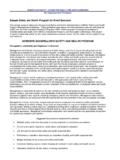Transcription of Sample Model Security Management Plan
1 WORKPLACE SAFETY: A GUIDE FOR SMALL & MID-SIZED COMPANIES By Hopwood and Thompson Sample Model Security Management plan Element #1: Policy Statement ( Security Management is an important enough topic that developing a policy statement, and publishing it with the program, is a critical consideration. The policy statement can be extracted and included in such documents as a new-hire employment packet, employee handbook, or placed on the company s intranet site.) A policy statement, in part, might read as follows: We are committed to maintaining the Security and well-being of our employees, visitors, and the surrounding community. Our Security Management program is but one aspect of our overall workplace safety efforts. Together, these efforts span personnel, information, and asset Security and include training and education activities to help ensure our programs success.
2 Additionally we will diligently work to comply with all applicable laws, regulations, and standards. Responsibility for this program has been vested with each department manager . Your cooperation with their efforts will help us all maintain a program that accomplishes all of its goals. We take specific actions toward identifying Security -related threats, including workplace violence, and threats that may exist from domestic or foreign terrorism. You (employees) can expand these efforts by reporting concerns and any Security breaches immediately. Your on-going knowledge and cooperation as well as participation with the Security Programs efforts will be appreciated, and again, help ensure its success. Thank You, Signed by Company Official Element #2: Compliance with Applicable Laws, Regulations, and Standards (Comment: To the extent that laws and regulations exist, efforts to comply and how you will comply should be delineated within the plan .)
3 All of the compliance efforts may not need to be repeated, specifically within an employee handbook, but should be a tactical element of a program. Some jurisdictions have not mandated specific plans, but have elements of applicable OSHA regulations, such as the General Duty Clause. In that case, indicate those that do apply. In this example, we ll use a California-based company.) There are various laws, regulations, and standards that apply to our program. We will comply with, at a minimum: Cal/OSHA General Duty Clause T8 CCR Section 3203 Cal/OSHA Emergency Action Plans T8 CCR Section 3220 Cal/OSHA s Guidelines regarding Workplace Security As other laws or regulations are introduced, we will integrate their provisions into our program. Element #3: Definitions (Comment: List definitions in this section that explain certain terminologies not readily understood by all.
4 The inclusion of definitions will help those that have to read and deploy the program and assist in training efforts. Examples of terms that may need definition include:) WORKPLACE SAFETY: A GUIDE FOR SMALL & MID-SIZED COMPANIES By Hopwood and Thompson Access Bomb threats Cal/OSHA Education Emergency Operations Center Incident Reporting Response Protocols Terrorism Threats Training Workplace Violence Others: (fill-in) Definitions critical to any Security Management Program will be included as they are learned. Element #4: Management Commitment and Responsibilities (Comments: Delineate, either in narrative or in outline form, the responsibilities of Senior Management , Management , and supervision if their responsibilities differ.
5 These responsibilities can be preceded, if necessary, by an internal use Management commitment statement, if desired.) Management commitment and responsibilities include: Program Management Program review and updates Development of a review panel or task force if hazards are identified, or for deployment after an event to assist in its review Assisting with training Enforcing disciplinary actions as needed Interaction and assistance with regulatory and response agencies This section can also include responsibilities for employees, especially those occupying specific roles (by position, not name). Element #5: Threat Assessment and Analysis (Comment: A core element of a Security Management Program is the identification of internal and external threats.
6 The mechanisms for identifying threats can be delineated in this section, detailing when assessments will be conducted, who will conduct assessments, and how findings will be modified at future dates if need be.) Security threat assessments will be: Completed prior to the initiation of this program Will be conducted as we become aware of new or potential threats Conducted for special events that we are either sponsoring or attending Our Security Management Committee, under the direction of the (General manager ) will conduct threat assessments on a scheduled or as required basis. In addition, the Committee will provide assistance. The use of other internal or external resources might be necessary as well. Threats will be qualified utilizing a threat matrix, or other tool that compares operations to threats, and their likelihood and severity.
7 Where possible, mitigating actions and recommendations will be initiated. WORKPLACE SAFETY: A GUIDE FOR SMALL & MID-SIZED COMPANIES By Hopwood and Thompson The threat matrix, after its initial completion and after any updates or modification, will be submitted to senior Management for review and approval. Element #6: The Role of the Security Program manager (Comments: Remember, even though the term Security is being used, and this program should be integrated with overall workplace safety activities, an organization may have an existing Security Department. As such alternate terminology may be needed if the two programs remain distinct and report to different managers.) The role of the Security manager includes: Lead role in threat assessments Program maintenance and updates Incident response and coordination Chair of the Security Program Committee Training Responsibilities Coordination with other Departments Coordination with agencies and response units Element #7: Employee Education and Training (Comments: Distinguish general awareness/educational from the tactical duties or training activities that are required.)
8 Our program will cover: Employee duties and responsibilities Event-specific responsibilities Threat or event reporting Back-to-work/check-in requirements Potential disciplinary actions Dealing with the media, regulatory agencies, or other entities outside the company Element #8: Management and Supervisor Education and Training (Comments: Managers and Supervisors will likely have specific duties and expectations ranging from threat identification and mitigation to their role in event response. Some of the responsibilities may mirror those of the employees, but are likely more specific in event response scenarios.) For Managers and Supervisors, our program focuses upon: Individual or Department duties Knowledge and deployment of response protocols Assuring employee and other constituent welfare Threat or event reporting Back-to-work/check-in requirements Potential disciplinary actions Dealing with the media, regulatory agencies, or other entities outside the company Element #9: Program Exercises and Drills (Comments: The training and education activities that will be undertaken for the purposes of the Security Management Program, shall be one of the following: case studies, table top exercises, or small and/or large scale exercises.)
9 WORKPLACE SAFETY: A GUIDE FOR SMALL & MID-SIZED COMPANIES By Hopwood and Thompson The appropriate methodology for training and education shall be at the discretion of the Program manager . Case Studies Case studies are in essence, paper and pen exercises. They provide an excellent opportunity to educate employees about the program, their responsibilities and basic response protocols. It is assumed that most case studies are conducted in a classroom setting, but in some instances, homework may be appropriate. In such cases, it is essential to have follow-up discussions to determine that the case study participant clearly understood what was being discussed in the assigned materials. The goal of case studies is to ensure knowledge of plans, procedures and job functions related to threat Management , response and administrative activities that may be assigned.
10 Other case study dynamics include: They must represent real world scenarios, and Case studies are ideally suited for initial program education as well as that which is specific to a department or specific scenario. Case Studies will be the primary educational activity for most of the employees. Where necessary or required, training sessions will be provided as well. Case study sessions will, at a minimum, include the procedures to follow in the event of: (All employees will participate in Case Studies) A bomb threat A violence in the workplace situation potential or actual Domestic violence occurring within our facilities General evacuation requirements due to a technical, human or natural threat Others as may be determined by the General manager or Security Management Committee, as examples.




